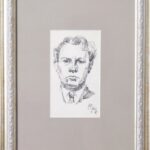
Jonynas Vytautas Kazimieras
1907-1997.
V. K. Jonynas was born on March 16, 1907 in Alytus County. He drew, sculpted, and carved from an early age. He received his secondary education at the Kudirka Naumiestis and Kaunas Gymnasiums, and in 1923-1929 he studied at the Lithuanian Art School in Kaunas.
In 1931 he went to Paris to continue his studies. The avant-garde atmosphere created by 40,000 artists in Paris, the capital of arts at the beginning of the 20th century, ignited faith in the power of art, and at the same time encouraged him to look back to past artistic experiences, because a true professional is one who has the whole world in him. V. K. Jonynas, like other young artists of his generation from Lithuania, discovers the plastic values of Lithuanian folk art (especially sculpture, graphics, textiles), where the profound spiritual experience of the nation and the sense of the world are encoded in centuries-purified forms, lines and colors. The exhibition begins with woodcuts created in Paris, in which, by reproducing the stylistic principles of folk carvings, the maturing artist gradually discovers his own language.
After graduating from two higher education institutions (in one he acquires a specialty in woodcuts and book art, in the other – in wooden sculpture and furniture construction) and having organized a personal exhibition, in 1935 he returns to Kaunas, participates in the activities of the young artists’ group “Ars”, teaches at the Kaunas Art School, and later – director of the Kaunas Institute of Applied and Decorative Arts.
In 1938-1939 creates woodcuts – illustrations for Kristijonas Donelaitis’ poem “Metai”. These illustrations are the gold fund of Lithuanian professional graphics.
According to the painter Antanas Gudaitis, this is a great work of art in all of Europe: extremely virtuosic, interesting in artistic conception. In 1940, he carves illustrations for P. Cvirka’s “Zemei maitintojai”, in 1942 he carves the “Zapyškio bažnyčia” (exhibited in the gallery). In 1944, the artist retires to Germany.
The world changes, the place of residence changes, the artist himself and his work change. In 1946, with the help of his good acquaintance R. Šmitlein, V. K. Jonynas establishes the Freiburg Art School. Most of its students and teachers are Lithuanians.
Alongside woodcuts, works created in other techniques appear – spontaneous 1946 The illustrations for W. Shakespeare’s “Hamlet” mark a new expression, the lithographs of 1950-1951 in Mainz radiate a harmonized spontaneity – “craftsmanship with soul”. Lithuanians working in Freiburg are influenced by French and German culture, their modern art. V. K. Jonynas also walks the path of discovery.
The German period is presented with woodcut illustrations for J. V. Goethe’s “The Sorrows of Young Werther” (begun in 1943 in Kaunas, completed in 1947 in Freiburg), P. Merimee’s “The Bear”. For the first time, illustrations for W. Shakespeare’s “Hamlet” (the book is unpublished), O. Milašius’s “Miguel Manjara” (the book is unpublished), J. V. Goethe’s “The Siege of Mainz” are exhibited. Drawings from nature of Nice, Freiburg, Villefranche, Monte Carlo, Sigmaringen, etc. landscapes, Mainz lithographs.
The artist’s tools and materials, woodcut clichés are exhibited. On an Italian tripod – a 1950 drawing of the sangina “Female Nude”.
The expanded collection of V. K. Jonynas’ postage stamps created for four German states is exhibited. In 1951, V. K. Jonynas left for the United States. He taught, founded the Stained Glass Studio. His stained glass windows have been implemented in 60 objects, most of them in churches, in some of which the artist created impressive homogeneous interiors. In the curved corridor of the gallery, in 16 frames, photo material, a small part of the religious art created by the professor is shown. In other rooms of the gallery – paintings, graphic works, drawings, sculptures, bas-reliefs, a four-part stained glass window. On display is a 1982 painting borrowed from the collector A. A. Juškis. painting work. Video material is shown in which the professor talks about his life and work, and the works are presented to churches.


